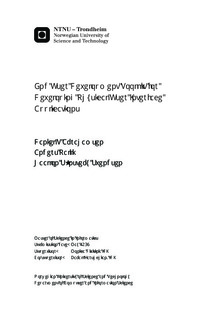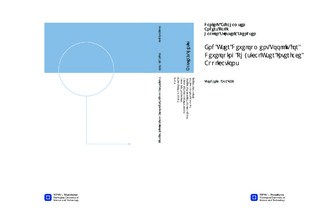| dc.contributor.advisor | Divitini, Monica | nb_NO |
| dc.contributor.advisor | Farshchian, Babak | nb_NO |
| dc.contributor.author | Abrahamsen, Daniel T | nb_NO |
| dc.contributor.author | Palfi, Anders | nb_NO |
| dc.contributor.author | Svendsen, Haakon Sønsteby | nb_NO |
| dc.date.accessioned | 2014-12-19T13:41:36Z | |
| dc.date.available | 2014-12-19T13:41:36Z | |
| dc.date.created | 2014-10-01 | nb_NO |
| dc.date.issued | 2014 | nb_NO |
| dc.identifier | 751698 | nb_NO |
| dc.identifier | ntnudaim:9025 | nb_NO |
| dc.identifier.uri | http://hdl.handle.net/11250/253785 | |
| dc.description.abstract | BACKGROUND: Tangible user interfaces and end user development are two increasingresearch areas in software technology. Physical representation promoteopportunities to ease the use of technology and reinforce personality traits ascreativeness, collaboration and intuitive actions. However, designing tangibleuser interfaces are both cumbersome and require several layers of architecture.End user development allows users with no programming experience to createor customize their own applications. OBJECTIVE: This dissertation aims toease development of tangible user interfaces by creating a toolkit, called RAPT(Rapid Arduino-Prototyping Toolkit), on the Arduino platform. RAPT will bedeveloped as an Android application to support mobility and accessibility. Therequirements of the toolkit are based on three scenario analysis; home assistance,restaurant and buddy notier. RESEARCH METHOD: First, this dissertationwill explore the underlying concepts of tangible user interfaces and end user development. Second, examine the state of the art within the domains of tangibleuser interfaces and end user development. Third, we will look at benets ofusing a software toolkit when developing a tangible user interface through anend user development interface. To solve these enquiries, we have conducted asystematic mapping study of tangible user interface and end user developmentdomains. Finally, requirement specications have been formed based on the scenarioanalysis. MEASUREMENTS: To evaluate the toolkit, we have conducteda usability test with ten non-programmers as the target group. RESULTS: Asa prototype, basic functionality is implemented and the usability test conrmsthat the toolkit is heading in the right direction by letting non-technical individualscreate and modify simplistic tangible user interface applications. Mainimprovements are to support other hardware than Arduino and making it easierto add new devices. The usability test illustrates that parts of the toolkit's userinterface can be hard to understand immediately, yet, it is easy to master. | nb_NO |
| dc.language | eng | nb_NO |
| dc.publisher | Institutt for datateknikk og informasjonsvitenskap | nb_NO |
| dc.title | End User Development Toolkit for Developing Physical User Interface Applications | nb_NO |
| dc.type | Master thesis | nb_NO |
| dc.source.pagenumber | 161 | nb_NO |
| dc.contributor.department | Norges teknisk-naturvitenskapelige universitet, Fakultet for informasjonsteknologi, matematikk og elektroteknikk, Institutt for datateknikk og informasjonsvitenskap | nb_NO |

